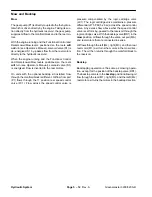
Testing
The most effective method for isolating problems in the
hydraulic system is by using hydraulic test equipment
such as pressure gauges and flow meters in the circuits
during various operational checks. (See the Special
Tools section in this Chapter.)
Before Performing Hydraulic Tests
IMPORTANT: All obvious areas such as oil supply,
filter, binding linkage, loose fasteners, or improper
adjustments must be checked before assuming that
a hydraulic component is the source of the problem
being experienced.
Precautions for Hydraulic Testing
CAUTION
Failure to use gauges with recommended
cedures could result in damage to the
gauge and possible personal injury from
leaking hot oil.
All testing should be performed by 2
people. One person should be in the seat
to operate the machine, and the other
should read and record test results.
CAUTION
Operate all hydraulic controls to relieve sys-
tem pressure and avoid injury from pressur-
ized hydraulic oil. Controls must be oper-
ated with the ignition switch in RUN and the
when pressure has been relieved. Remove
key from the ignition switch.
pressure (psi) rating as listed in test pro-
engine OFF. Return ignition switch to OFF
Before disconnecting or performing any
sure in the system must be relieved by
or
implements.
Keep body and hands away from pin hole
leaks or nozzles that eject hydraulic fluid
under high pressure. Do not use hands to
search for leaks; use paper or cardboard.
can have sufficient force to penetrate the
injected into the skin, it must be surgical-
ly removed within a few hours by a doctor
work on the hydraulic system, all pres-
stopping the engine and lowering
supporting the cutting units or other
Hydraulic fluid escaping under pressure
skin and cause serious injury. If fluid is
familiar with this type of injury. Gangrene
may result from such an injury.
WARNING
1. Thoroughly clean the machine before disconnect-
ing or disassembling any hydraulic components. Always
keep in mind the need for cleanliness when working on
hydraulic equipment. Contamination will cause exces-
sive wear of components.
2. Put caps or plugs on any hydraulic lines left open or
exposed during testing or removal of components.
3. The engine must be in good operating condition.
Use a tachometer when making a hydraulic test. Engine
speed can affect the accuracy of the tester readings.
4. The inlet and the outlet hoses must be properly con-
nected and not reversed (tester with pressure and flow
capabilities) to prevent damage to the hydraulic tester or
components.
Hydraulic System
Page 5 – 20
Greensmaster 3200/3200–D
Summary of Contents for 3200
Page 2: ...Greensmaster 3200 3200 D ...
Page 4: ...Greensmaster 3200 3200 D ...
Page 6: ...Greensmaster 3200 3200 D ...
Page 12: ...Safety Page 1 6 Greensmaster 3200 3200 D ...
Page 14: ...Equivalents and Conversions Product Records and Maintenance Page 2 2 Greensmaster 3200 3200 D ...
Page 17: ...Product Records and Maintenance Page 2 6 Greensmaster 3200 3200 D ...
Page 72: ...Perkins Diesel Engine Page 4 30 Greensmaster 3200 D ...
Page 113: ...Hydraulic System Greensmaster 3200 3200 D Page 5 41 Hydraulic System ...
Page 161: ...Hydraulic System Greensmaster 3200 3200 D Page 5 89 Hydraulic System ...
Page 173: ...Hydraulic System Greensmaster 3200 3200 D Page 5 101 Hydraulic System ...
Page 234: ...Wheels and Brakes Page 7 12 Greensmaster 3200 3200 D ...
Page 261: ...Cutting Units Greensmaster 3200 3200 D Page 8 27 Cutting Units ...
Page 273: ......
Page 274: ...Commercial Products FORM 96 900 SL E The Toro Company 1997 Printed in U S A ...
















































